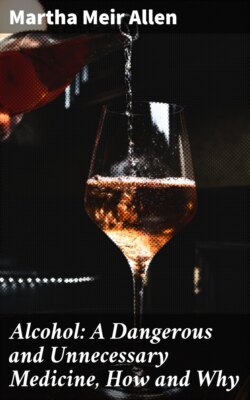Читать книгу Alcohol: A Dangerous and Unnecessary Medicine, How and Why - Martha Meir Allen - Страница 38
На сайте Литреса книга снята с продажи.
THE EFFECTS OF ALCOHOL UPON THE HUMAN BODY.
ОглавлениеTable of Contents
The body is made up mainly of cells, fibres and fluids. The cell is the most important structure in the living body. Life resides in the cell, and every animal may be considered a mass of cells, each of which is alive, and each of which has its own work to accomplish in the building up of the body.
The matter which forms the mass of a cell is called protoplasm, or bioplasm. It resembles somewhat the white of a raw egg, which is almost pure albumen. Cells make up the body, and do its work. Some are employed to construct the skeleton, others are used to form the organs which move the body; liver-cells secrete bile, and the cells in the kidneys separate poisonous matters from the blood in order that they may be expelled from the system.
These cells, composing the mass of the body, being very delicate, are easily acted upon by substances coming into contact with them. If substances other than natural foods or drinks are introduced into the body, the cells are injuriously affected. Alcohol is especially injurious to cells, “retarding the changes in their interior, hindering their appropriation of food, and elimination of waste matters, and therefore preventing their proper development and growth.”
“Bioplasm is living matter; it is structureless, semi-fluid, transparent and colorless. It is the only matter that can grow, move, divide itself and multiply, the only matter that can take up pabulum (food) and convert it into its own substance; and is the only matter that can be nourished. The bioplasm in the cell gets its nourishment by drawing in of the pabulum through the cell wall, and in that way building up the formed material while it is being disintegrated on the outer surface. This process is continually being carried on, and is what is meant by nutrition. Disintegration of the formed material is as essential as the building up of it. All organic structure is the result of change taking place in bioplasm. These small cell-like bioplasts are the workmen of the organism. All wounds are repaired by them, all fractures are united, and all diseased tissues brought back to their normal and healthy condition, unless there is not vitality enough to overcome disease, or they have been injured or killed by poisonous material. The body is kept in repair by this living matter, and all the functions of the body are but the result of its action. We may examine, watch and study bioplasm under the microscope; we see it take up pabulum and convert that which is adapted to itself into its own substance, while all other substances are rejected. We take a solution of what we call a stimulant and immerse the bioplasm in it, and we find that it increases its activity, moves faster, takes up more pabulum, and divides more rapidly than in the unstimulated condition. We next add an astringent, and it begins to move more slowly, and soon contracts into a spherical shape and remains contracted, or may move slowly to a limited extent, depending on the strength of the solution. We next take a relaxant, and gradually the living matter begins to spread in all directions, in a laxy-like manner, and becomes so thin as to be almost undiscernible, and takes up very little, if any, pabulum. If sufficiently relaxed or astringed, the movements may entirely cease so as to appear lifeless, but when a stimulant is again added the same result is obtained as before—it begins to move, and acts as vigorous as ever, which shows that it was not injured in the least by the agents used. Alcohol is called a stimulant. We take a weak solution of alcohol and try it in the same way; but we find that almost instantly the living matter contracts into a ball-like mass. Now, we may through ignorance suppose that alcohol acts as an astringent, and so we try to stimulate it with the same harmless agent before used, but no impression is made on it; it does not move; it is dead matter. These are demonstrable facts, and lie at the foundation of physiology, pathology and the practice of medicine. Alcohol destroys the very life force that alone keeps the body in repair. For a more simple experiment as to the action of alcohol, take the white of an egg (which consists of albumen, and is very similar to bioplasm), put it into alcohol, and notice it turn white, coagulate and harden. The same experiment can be made with blood with the same result—killing the blood bioplasts. Raw meat will turn white and harden in alcohol. Alcohol acts the same on food in the stomach as it does on the same substances before introduced into the stomach, and acts just the same on blood and all the living tissues in the system as out of it; and this alone is enough to condemn its use as a medicine.” From Alcohol, Is It a Medicine? by W. F. Pechuman, M. D., of Detroit, Michigan.
